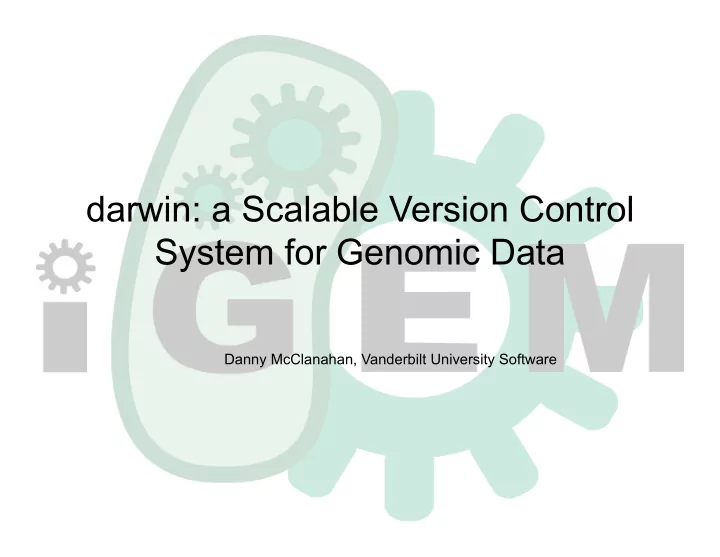

darwin: a Scalable Version Control System for Genomic Data Danny McClanahan, Vanderbilt University Software
Abstract Synthetic biologists create genomes by editing • DNA text directly. Changes made are difficult to track, which leads to • security problems. No software exists to track changes which works • with genome-scale data. darwin is a software package to document and • track collaborative changes to DNA on the genome scale.
Basic Biology Review ORF (open reading frame) codes for a protein • Are therefore the interesting parts of a gene • Can have multiple ORFs per gene • Translated by ribosomes in the cell • Has special start and end markers • Ribosome uses these to determine where to • begin and end translation into proteins
What is Version Control? Record every change made to a file or set of files • When, What, Who • Merge changes by multiple collaborators • Ensures every member of team has updated copy • Typical tool used is called git •
How Git Processes Files git is a line-based system • Only records lines added and deleted • AAAAAAAAA AAAAAAAAA -BBBBBBBBB BBBBBBBBB CCCCCCCC +DDDDDDDD CCCCCCCC DDDDDDDD previous current changes recorded The more lines in a file, the longer it takes git to • process. This makes it inefficient for processing DNA files •
What darwin Does darwin preprocesses DNA files before putting • them through git Create temporary file which is optimized so git • performs fewer operations and runs faster Put temporary file in git • Reconstruct original file from temporary file • Makes version control of genomic data feasible • by increasing the speed at which git processes data.
Approach Part 1: Split by ORF FASTA/GenBank/ApE/etc typically formatted in • fixed-length lines e.g.: • FASTA (typically 50 or 70 characters per line): • CATACAATCCAGGTTTTAATCATCAGAAATCACAGTCCTATTGTCTTCTGCACAGACCCAAACACACTTG GAGGTCATGTTCAATATGAATACCTCACAGAGAAGGAAATTTACACGCGAGAAGTACATCTGCAGAAAGC CAGCTGGCATGTCAACCATTCAAAAACTCAGGGTGTTCTGGATAAAGAAGACTCAGGAAGACAAGTATGA AGCATAATCTGTGACATTCCATGCGGCAGACATTAGACACATACAAGAGAGTTGTTGGAAAGCGGAATTT ATCTTCATATAAACAACACTGAGCTAAATCTCAATATTTCAGATCTCTAGAACTATCCATCAGTGAAATG ApE (typically 76 characters per line): • 1 TCGCGCGTTT CGGTGATGAC GGTGAAAACC TCTGACACAT GCAGCTCCCG GAGACGGTCA 61 CAGCTTGTCT GTAAGCGGAT GCCGGGAGCA GACAAGCCCG TCAGGGCGCG TCAGCGGGTG 121 TTGGCGGGTG TCGGGGCTGG CTTAACTATG CGGCATCAGA GCAGATTGTA CTGAGAGTGC 181 ACCATATGCG GTGTGAAATA CCGCACAGAT GCGTAAGGAG AAAATACCGC ATCAGGCGCC
Approach Part 1: Split by ORF Remove formatting • of FASTA/ApE/ GenBank/etc • Split file into lines • by ORF Changes to single • ORF now only affect single line Temporary file • produced is now much smaller
Approach Part 1: Split by ORF Output files now look like this • CATACAATCCAGGTTTTAATCATCAGAAATCACAGTCCTATTGTCTTCTGCACAGACCCAAACACACTTG GAGGTC ATGTTCAATATGAATACCTCACAGAGAAGGAAATTTACACGCGAGAAGTACATCTGCAGAAAGC CAGCTGGCATGTCAACCATTCAAAAACTCAGGGTGTTCTGGATAA AGAAGACTCAGGAAGACAAGT ATGA AGCATAATCTGTGACATTCCATGCGGCAGACATTAGACACATACAAGAGAGTTGTTGGAAAGCGGAATTT ATCTTCATATAA ACAACACTGAGCTAAATCTCAATATTTCAGATCTCTAGAACTATCCATCAGTGAA ATG Note that lines are now varying length, and • alternating between ORF and non-ORF Adding or modifying an ORF now only changes a • single line of output
Approach Part 2: Edits within ORF Consider adding a few amino acids at the • beginning of a long ORF: Before: ATGAGAGGCGGTTGC... • After: ATG AAAAGCATA AGAGGCGGTTGC... • Since git only sees changes in lines, it counts the • same as adding and removing an entire ORF This could be thousands of characters changed • for a single small insertion
Approach Part 2: Edits within ORF ATG AAAAGCATA AGAG… ATGAGAG… previous current -ATGAGAG… +ATGAAAAGCATAAGAG… changes recorded
Approach Part 2: Edits within ORF Identify ORFs • that have only small edits between two versions of file Find only those • small changes that were made and record those Actual ORF can • be reconstructed from previous ORF + changes
Approach Part 2: Edits within ORF Previous example: • Before: ATGAGAGGCGGTTGC... • After: ATG AAAAGCATA AGAGGCGGTTGC... • This turns into: • ATGAGAGGCGGTTGCA... • +AAAAGCATA@3 • Short line of edits added, not entire long ORF •
Approach Part 3: Use of Concurrency Water bucket analogy • File I/O (input-output) is extremely slow • darwin has to do both input and output • So use concurrency to continue to do work • while waiting for slow file operations
Approach Part 3: Use of Concurrency Create queues of “buckets” of input and output • First bucket passed from file reader to processor • File reader continues reading while processor • completes Finally, bucket passed from processor to writer •
Approach Part 3: Use of Concurrency Perform four cycles side-by-side in same time as two • cycles without concurrency Massive pipelined speedup available •
Results Speedup Tested on multiple • iterations of ApE files from Vanderbilt wetware team darwin made • processing files with git about twice as fast
Results Data about experimental setup • 40,000 trials run on four successive iterations of a • real-life DNA file “wall-clock time” used to measure time actually • visible to the user Why do results matter? • This experiment shows that even a draft copy of the • software can achieve extremely impressive results.
Future Work More filetypes: • 2bit, SAM/BAM, etc • GUI • Further optimization •
Project Summary darwin is a software package to document • changes to DNA. Allows for easy, standardized, and collaborative • editing on DNA data up to the genome scale. Builds off of tested and proven version control • software. Uses algorithms to preprocess DNA files and • log changes twice as fast as the current method.
Acknowledgements Mitchell Gordon, for software development. • Jules White, for advice and help. • VUSE, and specifically the EECE department, • for their support throughout this project.
Recommend
More recommend